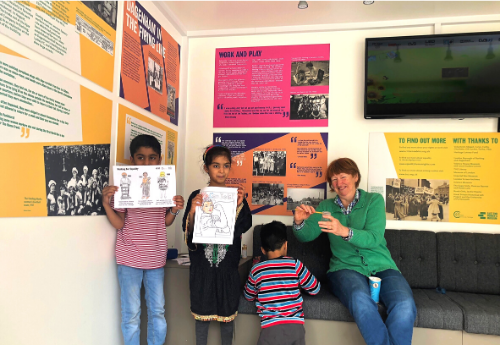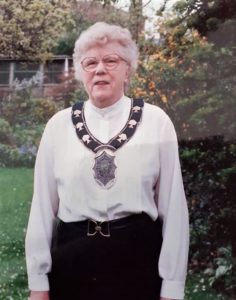Is it time to make women’s history visible? At Soroptimist East London we think so. We’re huge fans of women’s history – why? Because it’s our history – the stories of all the women who have contributed to making us who we are today. So we asked Rachel Crossley, Director of the East End Women’s Museum to tell us more about what they are doing to make women’s history of East London visible to all. This is her guest blog.
Women’s history is just 0.5% of recorded history – we have work to do
By Rachel Crossley, Museum Director, East End Women’s Museum
It’s been suggested that women’s stories account for a paltry 0.5% of recorded history.[1] While it might seem almost unbelievable, there are more UK statues of goats than of Black women; more statues of pigs than of Muslim women; and more of men named John than of any non-mythical, non-royal women.[2] Even in contemporary records, these sorts of trends are replicated, with only 18% of Wikipedia biographies of women for example.[3] Women’s lives have simply not been deemed as noteworthy, with the traditional focus on ‘great men’ of the royal, political and military spheres overlooking women’s more subtle, collaborative and domestic – but no less critical – contributions.
When I think back to my own history lessons at school, I can only remember learning about two women – Boudicca and Elizabeth I. And while I’m generally a fan of flame-haired, formidable females, it was hardly a diverse or rounded view of women of the past.
As well as neglecting a wealth of fascinating lives historically, I also worry about what this might mean for women and girls today. Even though it’s now over 100 years since two landmark moments of 1919 – the Sex Discrimination (Removal) Act enabling women to work in the professions for the first time, and the first woman to take her seat in Parliament – currently women make up only ⅓ MPs[4], and just 5% of FTSE100 leaders.[5] With such a long way off 50:50 representation, how can we be confident that women and girls today can truly be anything they want to be?

We at the East End Women’s Museum want to balance the history books and challenge contemporary inequality. Since 2015, we’ve been working to put some of the missing women back in the picture, through archive research, volunteer-led oral history interviews, exhibitions and events. We’ve also been facilitating people to tell their own stories and those of their families and local communities – ensuring they make their mark so that future historians can know of their lives.


We tell stories of ‘ordinary’ women as well as more well-known figures – we find that everyone’s life has an element of the extraordinary in it. For example, take Adelaide Knight. She was the leader of the first London branch of the Women’s Social and Political Union (WSPU), based in Canning Town, Newham. After a childhood injury, she used crutches or a stick to walk, and experienced repeated ill health. Nevertheless she was a fearless suffragette, who went to prison rather than give up campaigning, despite meaning spending time away from her two small children and exacerbating her poor health. Adelaide Knight was also a pioneer in that she had an interracial marriage with mixed-race sailor Donald Adolphus Brown. Very unusually for the late 19th century, he took her surname, and the couple shared domestic chores.
Or get to know Josie Woods, a Black woman from very humble beginnings in Canning Town. Aged 14 in 1926 and then working in a tailor’s shop, she was picked out by American music hall star Belle Davis as having star quality. Belle Davis was right – and Josie Woods found great success as a dancer, including performing at the La Revue Negre in Paris (the show that had earlier made Josephine Baker’s name). Josie Woods later became an actor, teacher and choreographer. She remained passionate about equality, including leading a strike for Black extras over late payment, while working on a film in 1951.
Or hear the story of Amelia Harris – contributed to our website by her granddaughter Josie Glausiusz – born to Russian Jewish parents in 1906. Amelia Harris grew up in Hoxton, Hackney, and had a colourful and varied career from boot polish peddler, to dressmaker, to insurance agent for the Prudential during the Second World War. Despite many challenges, including surviving breast cancer and experiencing anti-immigrant sentiment, she remained “strong, almost indomitable; outspoken, independent, stubborn, warm, loving, and a lover of life”.
And of course, we have plenty of stories to tell of Soroptimists! Women like Titanic survivor Eva Hart and women’s refuge pioneer Gladys Worland, both lifelong Soroptimists whose stories have been kindly added to our women’s history map by SI East London. We also know about Mary Harris Smith and Ethel Watts, two of the earliest female Chartered Accountants who did the audits for the Soroptimists in its very early days.

Truly, there are so many women’s lives and voices we won’t hear without being proactive about capturing, safeguarding, and sharing them. That’s what drives the East End Women’s Museum to do what we do. In our time we’ve chatted to female shoppers and stallholders at the historic Watney Market; marched at the 80th anniversary of the Battle of Cable Street to remember the women anti-facist protesters among the crowds; asked women of Hackney what activism means to them in a long local tradition from Mary Wollstonecraft to Diane Abbott; and recorded oral histories of women, now in their 80s and 90s, who were factory workers before the 1970 Equal Pay Act.
And we won’t stop there! For five years we’ve operated as a pop-up and virtual museum, sharing women’s stories in different community spaces and online. But now, we’re working towards opening our first brick and mortar museum in late 2021 – the only dedicated women’s museum building in England.

The site is located in a new development in Barking town centre, close to the ruins of Barking Abbey (which itself was a significant seat of women’s power, learning and writing in medieval times[6]). While we’ll continue to work in the community and online too, the building will give us a permanent home and a base from which to expand our ambitions even further – for example, hosting school and group visits and holding more exhibitions and events. Over the next year we’ll be designing the building in conversation with our local community, and we can’t wait to open the doors next year. And no, we won’t stop until that 0.5% turns into 50% (at the very least!).
Help support the East End Women’s Museum
We couldn’t do our work without the brilliant support of our community and friends. If you’ve been inspired by this piece:
- Please sign up for our e-newsletter and follow us on Twitter and Facebook to be the first to hear about our building development, new exhibitions and events.
- If you’d like to contribute a story to our website – either as a short map entry or as a longer blog piece – please get in touch.
- We’re a tiny, independent charity and donations go a long way. If you’re in a position to help support us to realise our big ambitions, please consider doing so.
Interested to find out about Soroptimist East London?
If you’re interested to find out more about Soroptimist East London, or join, contact us.
We’re a vibrant and friendly group of women who work, live or have connections to East London/City. What do we do? We empower women for positive change and sustainable development right here in east London and around the world. You can read all about it in our blog What Does Soroptimist East London and check our activities, our history and events.
Rachel Crossley of the East End Women’s Museum will be speaking at our on-line meeting on 20 October 2020 at 7pm – you’re invited. If you would like to attend, please register HERE!
And remember, you can keep up to date with our news by following us on Twitter and Facebook!
[1] http://blog.english-heritage.org.uk/women-written-history-interview-bettany-hughes/?_ga=2.109810572.801992371.1601626490-122631883.1597826406
[2] https://twitter.com/EEWomensMuseum/status/1271475141990547460
[3] https://en.wikipedia.org/wiki/Wikipedia:WikiProject_Women
[4] https://commonslibrary.parliament.uk/research-briefings/sn01250/
[5] https://www.businessleader.co.uk/discover-the-female-ftse-100-ceos-of-2020/81145/
[6] https://www.historytoday.com/archive/out-margins/cultured-women-essex

